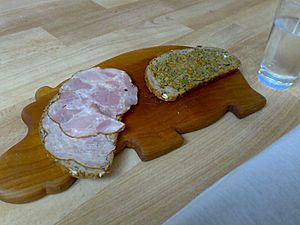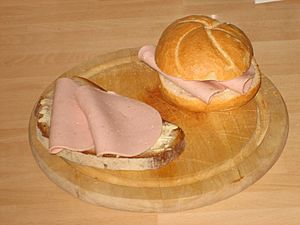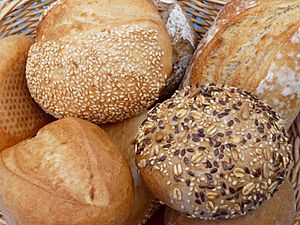Butterbrot facts for kids
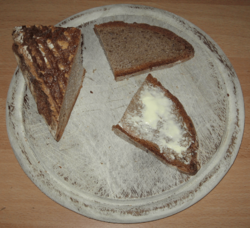 |
|
| Type | Sandwich |
|---|---|
| Place of origin | Germany |
| Main ingredients | Bread, butter |
A Butterbrot is a German word that means "butter bread." It's basically a slice of bread with butter on it. Even if you add cheese, sweet toppings, or a slice of sausage, it's still often called a Butterbrot!
In Germany, people use many different words for Butterbrot, depending on where they live. Some common names include Stulle, Schnitte, Botteramm, Bütterken, Bemme, or Knifte.
Even though other foods are becoming more popular, Butterbrot is still a common food in Germany. Since 1999, the last Friday in September has been known as the Day of German Butterbrot.
The word buterbrod was also adopted into the Russian language from German. In Russia, it means a slice of bread with anything on top. From Russian, the word spread to other languages like Azerbaijani, Belarusian, Georgian, Kazakh, Ukrainian, and Lithuanian.
Butterbrot vs. Sandwiches
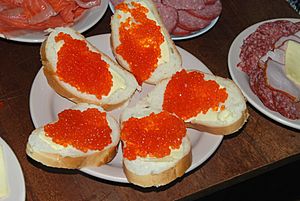
A Butterbrot is usually just one slice of bread with butter or margarine and one main topping.
For breakfast, people often put sweet things on their Butterbrot. This could be marmalade, jam, honey, chocolate spread, or hazelnut spread.
For dinner or as a packed lunch, Butterbrot often has savory toppings. These might include cold meat, cheese, sliced German Wurst, or different kinds of cream cheese. You might also find Schnitzel, hard-boiled egg slices, or smoked salmon on top. There are also many vegetarian spreads.
Sometimes, a Butterbrot for lunch is folded in half to make it easier to eat. When it's folded, it looks a bit like a sandwich.
In Austria, the word Butterbrot only means bread with butter. If you add a topping, they call it by the topping's name. For example, Käsebrot means "cheese bread," and Wurstbrot means "sausage bread."
German Butterbrot is often made with different kinds of bread than English sandwiches. German breads are usually firmer, have more moisture, and a crispy crust. A popular type is Vollkornbrot, which is a wholegrain bread. It has a slightly sour taste because it uses sourdough. Many German breads also contain rye.
However, Germans also eat many kinds of white or mixed breads. Baguette and ciabatta are very common. Many families also eat toast with toppings for breakfast because it's quick and cheap. Another very popular bread type is Brötchen, which are bread rolls. There are countless types of Brötchen in Germany!
The toppings on a Butterbrot are usually simpler than on a sandwich. People typically put one slice of cheese or one or two slices of cold meat. Adding things like lettuce, tomato, pickles, onions, mustard, or mayonnaise is less common. The amount of topping compared to the bread is usually kept balanced. You won't often find very thick, fancy fillings like you might see in some sandwiches.
Germans use the English word "sandwich" to talk about the British-style sandwich, to tell it apart from their own Butterbrot.
Butterbrot Today
In German-speaking countries, Butterbrot has slowly been replaced by other breakfast foods like muesli, cereals, or toast. During the day, people often buy bakery items to eat on the go.
However, Butterbrot is still a common food for many Germans. It's especially popular in the evening. People also enjoy eating it on hiking trips. In many parts of Germany, Butterbrot is still very common for a second breakfast at school or work. It's eaten much more often than fast food, for example.
In Russia, Ukraine, Belarus, and other countries that were part of the Soviet Union, buterbrod is still very popular. It's usually seen as different from a "sandwich." In Russian, the word сэндвич (sandwich) is used for two slices of bread with something in between, especially sandwiches from fast-food places.
Fun Facts and Legends
There's a funny saying that a Butterbrot always falls to the floor with the buttered side down. This is like Murphy's law, which says that if something can go wrong, it will. One idea why this happens is that the top side of the bread, with butter and toppings, is often heavier. This makes it more likely to land face down. This idea has even been explored on German children's TV shows!
People also joke about what would happen if you tied a Butterbrot to the back of a cat. Cats are famous for always landing on their feet. So, would the cat still land on its feet, or would the Butterbrot make it fall on its back? Some people even humorously suggest the cat might just float in the air, unable to decide which way to land!
See also
 In Spanish: Butterbrot para niños
In Spanish: Butterbrot para niños


